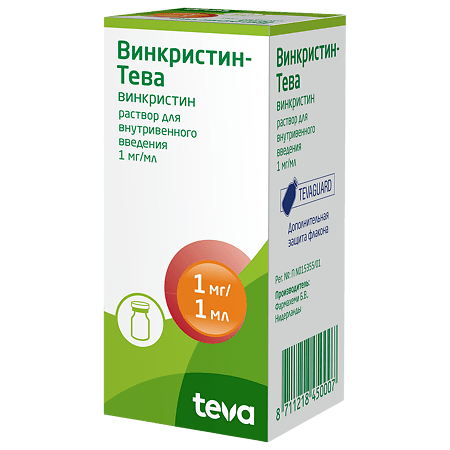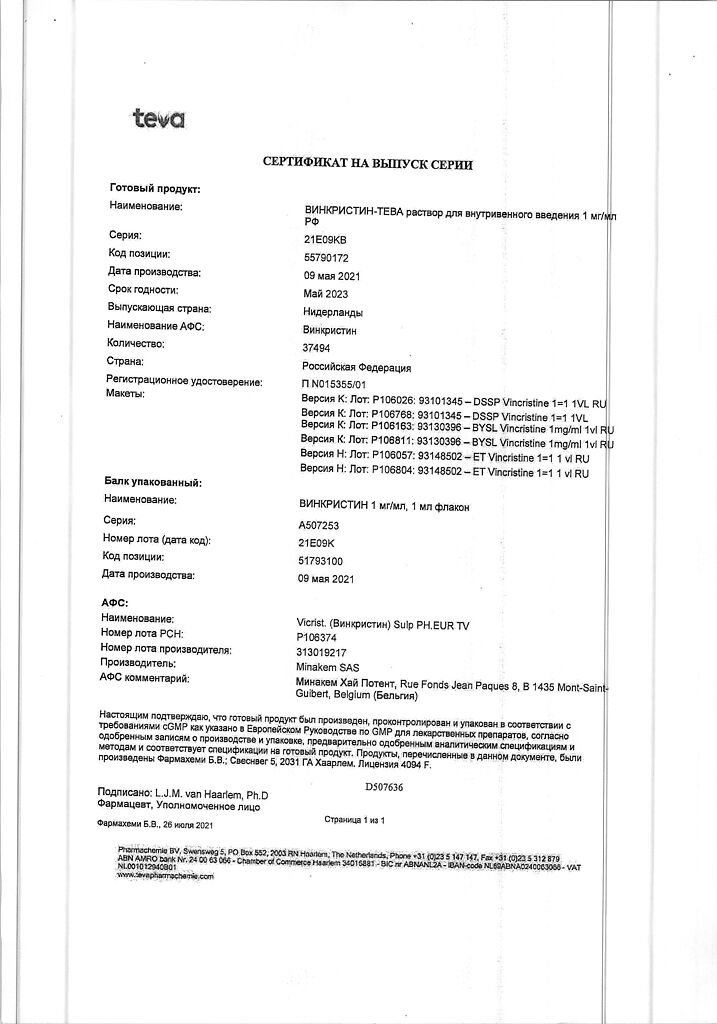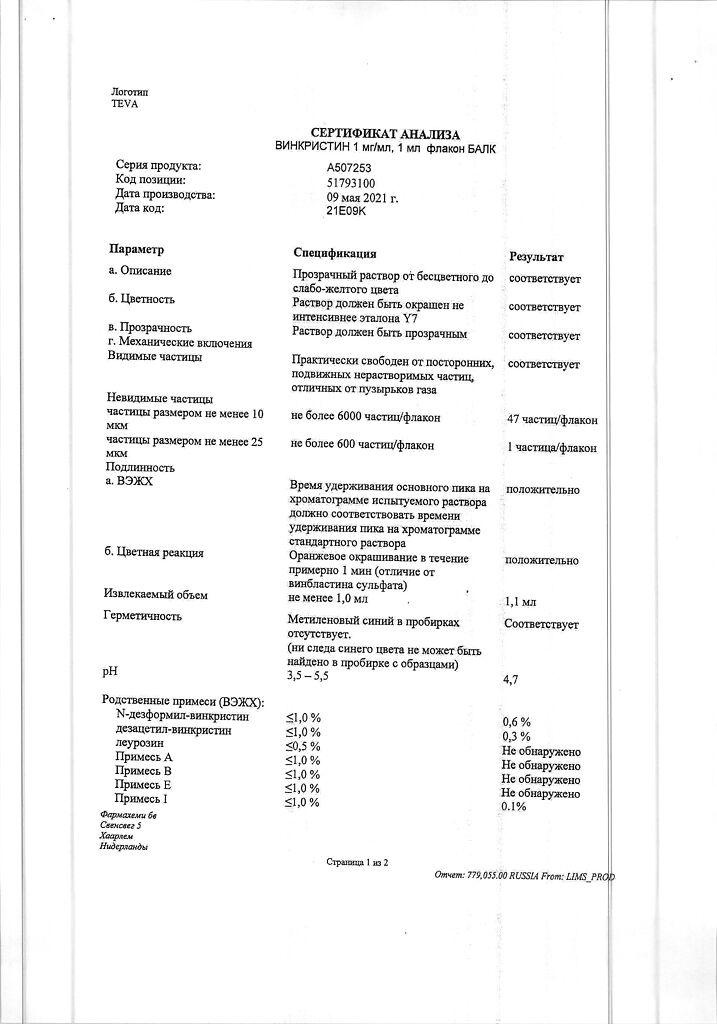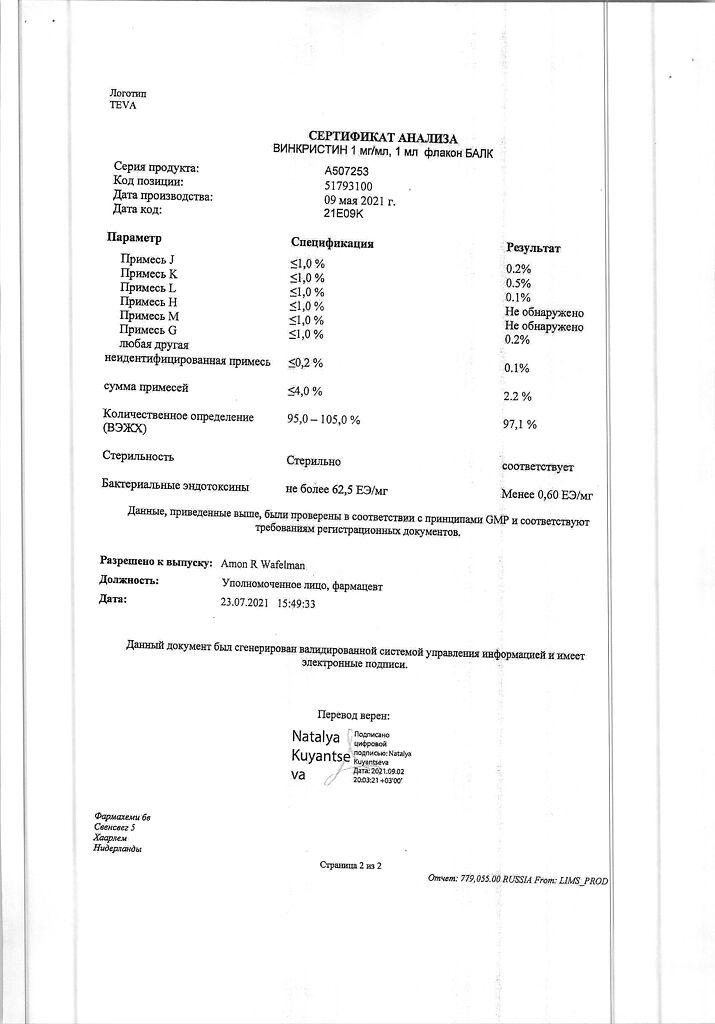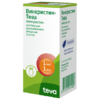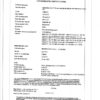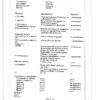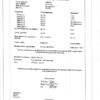No products in the cart.
Description
Pharmacodynamics
A plant-based antitumor agent.
Vincristine is a pink periwinkle alkaloid and belongs to the cytostatic chemotherapeutic agents. Vincristine binds to tubulin protein and leads to disruption of the microtubule apparatus of cells and rupture of the mitotic spindle. < br>
Suppresses mitosis in metaphase. It also inhibits glutamate metabolism and possible nucleic acid synthesis and has immunosuppressive effects.
Pharmacokinetics
After IV administration, vincristine is rapidly eliminated from the blood. About 90% of the drug is bound to plasma proteins. Vincristine is metabolized in the liver and excreted mainly with the bile; 70-80% of the drug is detected in the feces unchanged and as metabolites, 10-20% of the drug is determined in the urine. The initial, median and final T< sub>1/2 are 5 min, 2.3 h, and 85 h, respectively. Terminal T< sub>1/2 can range from 19 to 155 h. Vincristine does not penetrate well through the HEB.
Indications
Indications
Active ingredient
Active ingredient
Composition
Composition
1 ml of the solution contains:
Active substances:
Vincristine sulfate 1 mg.
Auxiliary substances:
Mannitol,
Sodium hydroxide,
Sulfuric acid,
water d/i.
In a bottle of 1 ml.
There is 1 vial in the carton pack.
How to take, the dosage
How to take, the dosage
Intrathecal administration of vincristine is prohibited.
Vincristine is given strictly intravenously at 1 week intervals. The duration of injection should be approximately 1 minute.
Before injection, the contents of the bottle are diluted in the included solvent with just the required amount of 0.9% sodium chloride solution to a concentration of 0.1 mg/ml.
Please use caution when administering to avoid extravasation.
The dose is adjusted individually. The average dose for adults is 1.4 mg/m2 body surface, a single dose should not exceed 2 mg; for children, 1.5-2 mg/m2 body surface. In children up to 10 kg, the starting dose should be 0.05 mg/kg/week.
In patients with liver dysfunction and plasma bilirubin concentrations above 51.3 μmol/L, a 50% reduction of the dose is recommended.
Interaction
Interaction
Vincristine may decrease the anticonvulsant effect of phenytoin.
In concomitant use with neurotoxic drugs (isoniazid, itraconazole, nifedipine) an increase in adverse effects on the nervous system is observed.
In concomitant use vincristine weakens the effect of antipodagric agents. When concomitant use with drugs that increase serum uric acid levels, the risk of nephropathy increases.
When administered in combination with mitomycin C, vincristine may cause severe bronchospasm.
If the drug must be used in combination with L-asparaginase, vincristine should be administered 12-24 hours before L-asparaginase. Administration of asparaginase prior to administration of vincristine may interfere with its excretion from the liver.
The concomitant use of vincristine with other myelodepressant drugs and prednisolone may increase inhibition of medullary hematopoiesis.
Special Instructions
Special Instructions
Intrathecal administration of vincristine can lead to death.
Hematological monitoring should be performed regularly during treatment. Special caution should be exercised if leukopenia develops when repeated doses are administered.
In case of elevated uric acid levels, alkalinization of urine and administration of uricosynthesis inhibitors are recommended.
The dose of vincristine should be reduced if liver function tests are elevated.
The serum sodium ion concentration should be determined periodically. For correction of hyponatremia, administration of appropriate solutions is recommended.
Patients with a history of neuropathy require special monitoring.
With caution, Vincristine should be administered to elderly patients as neurotoxicity may be more pronounced in these patients.
Any complaint of eye pain or decreased vision requires a thorough ophthalmologic evaluation.
Avoid getting vincristine solution in the eye. If this happens, rinse the eyes thoroughly and profusely with plenty of fluid immediately.
Impact on the ability to drive vehicles and other mechanisms requiring increased concentration
Vincristine neurotoxicity may adversely affect the ability to drive.
Contraindications
Contraindications
Side effects
Side effects
CNS and peripheral nervous system disorders: convulsions with BP increase, paresthesias, neuralgia, neuropathy, jaw pain, decreased muscle strength, loss of tendon reflexes, ataxia, headache, depression, hallucinations, sleep disorders, diplopia, ptosis, transient blindness and optic atrophy. Neurotoxicity is a dose-limiting factor.
Digestive system disorders: nausea, vomiting, stomatitis, constipation, paralytic intestinal obstruction (particularly common in children), abdominal pain, small bowel necrosis and/or perforation, diarrhea.
Urinary system disorders: polyuria, dysuria, urinary retention due to bladder atony, edema.
Cardiovascular system: increase or decrease of BP. In patients with previously irradiated mediastinum when using polychemotherapy with vincristine included, angina and myocardial infarction may occur.
Respiratory system: acute dyspnea and severe bronchospasm have been observed when using vincristine with mitomycin C.
Endocrine system disorders: a syndrome due to impaired secretion of antidiuretic hormone is rarely observed, which is characterized by large excretion of sodium in the urine and causes hyponatremia. There are no signs of renal and adrenal damage, arterial hypotension, dehydration, azotemia and edema.
Hematopoietic system disorders: does not significantly affect hematopoiesis. However, moderate leukopenia, thrombocytopenia and anemia may be observed.
Local reactions: If the drug gets under the skin, cellulitis, phlebitis, and even, necrosis may develop.
Others: alopecia, rash, amenorrhea, azoospermia.
Overdose
Overdose
In an accidental overdose, increased side effects of Vincristine should be expected. A specific antidote is not known.
The treatment is symptomatic and should include restriction of fluid intake, prescription of diuretics (to prevent complications associated with the development of syndrome of increased secretion of antidiuretic hormone), use of phenobarbital (to prevent convulsions), use of laxatives (prevention of bowel obstruction). The cardiovascular system should also be monitored and hematologic monitoring should be performed. Hemodialysis is not effective.
In addition to the above, leucovorin at a dose of 100 mg w/v every 3 h for 24 h and then every 6 h for at least 48 h may be administered.
Additional information
| Shelf life | 2 years |
|---|---|
| Conditions of storage | In a light-protected place, at 2-8 °C |
| Manufacturer | Pharmahemi B.V., The Netherlands |
| Medication form | solution |
| Brand | Pharmahemi B.V. |
Related products
Buy Vincristine-Teva, 1 mg/ml 1 ml with delivery to USA, UK, Europe and over 120 other countries.

